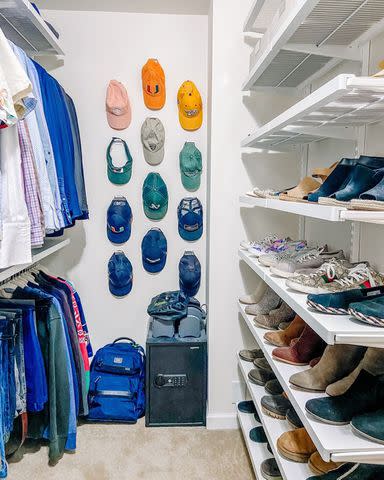Table of Contents
“Swedish death cleaning” may sound morbid, but the concept is less doom and gloom and more existential and sweet. Think of the decluttering style this way: if the KonMari Method and hygge had a baby, it’d be Swedish death cleaning.
The idea is simple, yet astounding. Swedish death cleaning is a Scandinavian method of organizing that focuses on decluttering your home before you pass on in an effort to lessen the burden on your grieving loved ones. Author Margareta Magnusson coined the phrase in her 2017 book The Gentle Art of Swedish Death Cleaning, and the concept has been gaining traction ever since.
My space was in serious need of tidying, so I tried out the method in my own home. By taking on the Swedish death-cleaning mindset, not only did I earn a tidier, more minimalistic space, but through the process, I gained a deeper appreciation for life, too.
Meet the Expert
-
Erica Thompson is the owner of Organized by Design, a professional organizing business located in Los Angeles.
-
Morgan Ovens is the founder of Haven Home Wellness, a professional organizing service based in the San Francisco Bay Area.
How Experts Define Swedish Death Cleaning
With a serious Swedish death cleaning spree, you’ll ensure you’re only surrounded by items you love, want, and need. So long, stack of college textbooks you haven’t cracked open in a decade. You too, box of dead batteries.
“It’s freeing for everyone,” says Erica Thompson, owner of Organized by Design. “It helps people let go of attachments and distractions and welcome in something new. It’s also a way to show love and selflessness to your friends and family by unburdening them.”
One look at the clutter in the corner of your closet, and you’ll agree. Excessive items, from mystery cables to ill-fitting dresses, can pile up without much thought.
“If we aren’t intentional about what we’re surrounding ourselves with, stuff can easily pile up and not only take over our physical space, but our minds as well, creating excess stress and overwhelm,” says Morgan Ovens, founder of Haven Home Wellness. “When we clear space at home, we also create space in our lives for future opportunities to arise.”

How to Start Swedish Death Cleaning
Magnusson’s book recommends starting the death-cleaning process in your 60s, but it’s a healthy mindset anyone can adopt, no matter your age.
Since the process can be overwhelming, start small, both in terms of space and amount of time. Begin with a single drawer or your car, or set a timer for 30 minutes. That way you can stay motivated without making an even bigger mess.
Ovens recommends starting with a space or category of items that will be easy for you to make decisions about, like a pantry full of expired canned goods or a bathroom overflowing with too many hair products. That’ll build your confidence to move onto areas with more sentimental attachment, like clothing or keepsake items.
“Go for the easy win and build from there,” Thompson says.

I Tried Swedish Death Cleaning—Here’s What Happened
Never one to turn down an organizational challenge, I was quick to adopt the Swedish death cleaning method in my own home. I run a tight, minimal ship, and honestly have always had this cleaning mindset—just never a name for it.
Maybe it’s the curse of being the youngest child with older siblings who’d read her childhood diary. I’ve always been aware of who would inherit my belongings, and how embarrassed I’d be (even after death) if that happened. That’s why those aforementioned journals were tossed years ago—no one needs to read about which boy I was crushing on in 2002.
As I decluttered, space by space, I checked in with my internal sentimental meter, which instinctually tells me if I’m ready to part with an item or not. High school yearbooks? Goodbye. That dress I haven’t worn since 2017? Donated. This may sound callous, but I firmly believe you should have a high standard for what you surround yourself with.
I can be a softie, but only towards items that remind me of someone, somewhere, or some time. The hand-made ceramic dish I bought in Portugal, which I toss my jewelry into every night, stays. So does the blanket my mother knit me years ago, a small folder of elementary school relics, and an old love note scribbled on a bar napkin. To be able to look around your space and get the warm fuzzies from most of the items around you is special.
Turns out, we won’t be here forever. May as well make the most of our time, surrounding ourselves with memory-soaked items we love—and would love to pass on. After all, after I die I want (demand, even) my loved ones are cheers-ing in my memory, not stuck sorting through a stack of dusty The O.C. DVDs.
Read Next: 9 of TikTok’s Favorite Cleaning Products That Really Work
Read the original article on The Spruce.
